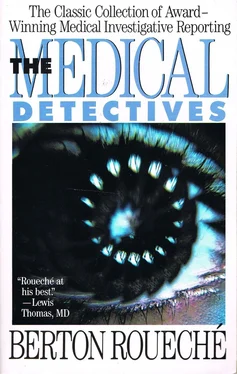The 1985 thyrotoxicosis outbreak and its successful investigation had consequences of more than local interest. One of these was that on August 29 the United States Department of Agriculture issued an advisory to all U.S.D.A.-inspected plants which temporarily prohibited trimming near the gullet in beef (and pork) used for human consumption. That prohibition was later made permanent.
[1988]
CHAPTER 25
The Foulest and Nastiest Creatures That Be
I saw my first tick in the back yard of a rented house in East Hampton, on the oceanic East End of Long Island, one afternoon in July of 1949. It was on my wife's back. We had just come home from the beach, and the tick was conspicuously poised on the bare skin between the top and the bottom of her two-piece bathing suit. We had only recently moved east from Missouri, where the insect pest of summer is not the tick but the chigger. Still, I knew what a tick looked like, and I knew—or had heard—that there was an approved way of removing one from the flesh of its victim: apply the lighted end of a cigarette. I had a cigarette in my hand (as I often did in those innocent days), and I carefully applied the lighted end to my wife's nicely tanned back. She gave a scream. The tick did not, as the approved method promised, drop to the ground. It merely crawled a millimeter or two to the right. Instinct guided me next. I reached out and plucked it off with my thumb and forefinger. Before I killed it, before I crushed it with a pebble, I took a closer look. It was almost the size of a ladybug, only flat, with a shiny brown carapace and a yellowish capelike collar. It had eight spindly legs and a tiny snout of a head. It was ugly, but it looked—though I knew it wasn't—harmless. That, as I say, was my first tick, but hardly my last. I have since seen hundreds, perhaps thousands, in the wild and—crawling, sitting, or embedded—on me, on my wife, on my son, and on several generations of dogs.
The tick is not, to be puristic, an insect. It belongs, in the nomenclature of science, to the phylum Arthropoda and is a member (along with spiders, scorpions, mites, and the horseshoe crab) of the class Arachnida. Ticks are found in incomprehensible numbers throughout the world, and man has probably been unpleasantly aware of them since his beginnings. Human detestation of the tick easily surpasses that aroused by snakes and spiders. "Ill-favored ticks," Pliny the Elder (23-79 A.D.) cried out in his "Natural History." "The foulest and nastiest creatures that be." I know of no better confirmation of the theory of evolution than the tick. That is to say, it is hard to think of the tick, which lives on the blood of other creatures but is itself food for none, as a deliberate creation, as one of the creatures in Genesis "that creepeth upon the earth," and to believe that it had a Creator who "saw that it was good." My first tick—and, with one considerable exception, all of the many ticks I have seen—was of the species Dermacentor variabilis , the dog tick. It is, like all ticks, parasitic, but is itself often host to the bacterium Rickettsia rickettsii , the agent of Rocky Mountain spotted fever. Rocky Mountain spotted fever takes its name from the region (the mountains of Idaho and Montana) in which, in the eighteen-nineties, it was first identified, but it is no longer seen as merely a provincial menace. Its geography is now known to embrace most of the Western Hemisphere. It has, however, its favored haunts. These include, along with the mountain West, much of the states of Georgia, North Carolina, Virginia, and Maryland, coastal Connecticut and Massachusetts, and eastern Long Island.
Rocky Mountain spotted fever is a dangerous disease. The average incubation period—the interval between the bite and leisurely blood meal of an infected tick and the appearance of illness—is about seven days. The onset is often abrupt, with high fever, chills, headache, prostration, and other more or less equivocal manifestations. The characteristic spotted rash seldom appears before about the fourth day. Immediate diagnosis is consequently difficult unless the disease is suspected—unless the diagnostician is morbidly alert to its possible presence or unless the victim can inform him of a recent tick bite. This last is only sometimes feasible. Ticks seem to seek out secluded feeding sites—the armpit, the scalp, the navel. An effective treatment for Rocky Mountain spotted fever, involving a tetracycline antibiotic, has been available since the middle nineteen-fifties. Untreated or improperly treated cases have a high mortality—around twenty per cent. I was aware of Rocky Mountain spotted fever at the time of my introduction to D. variabilis , and I made it my business to learn more. I learned from local lore that the vector tick is ubiquitous in range, finding a comfortable habitat in fields and pastures, in brush and woods, in the grassy dunes that border the most pleasant beaches, and even in the best-kept lawns, and that its preferred hosts are rabbits, mice, squirrels, and dogs. Man is merely faute de mieux . I learned from a local doctor that there was no effective treatment for Rocky Mountain spotted fever (the tetracyclines were yet to come), but that there was a vaccine. My wife and son and I presented ourselves at the local clinic and were immunized. I have a vivid recollection of that vaccination: a moment after the injection, my arm received what felt like a blow from a baseball bat, and an ache that persisted for some hours. But it seemed well worth that little discomfort. I lived the next thirty-odd years—sunning myself on beachy dunes, strolling in brushy pastures, cutting firewood—in the carefree knowledge that my wife and son and I were immune to Rocky Mountain fever, and I removed any ticks I attracted as nothing more than nuisances. It was only recently that I learned that all R. rickettsii vaccines had long since been found to be unreliable and had been withdrawn from the market.
I understand now, having made some inquiries, how I happened to escape contracting Rocky Mountain spotted fever in spite of my unconcerned wanderings for so many years in an area in which the disease is historically endemic. It was, of course, in large part luck. But the odds were very much in my favor. It is estimated that even in heavily infested areas only about five per cent of the vector ticks are carriers, and it is a comforting fact that the dog tick (and its carrier cousins) is an indecisive feeder. It usually crawls around the skin of a human host for some little time before it chooses a place to eat. During those preliminary perambulations, it presents no kind of threat, and even when it settles down and thrusts its proboscis into the skin the migration of the R. rickettsii bacterium to its new host seems to take time—perhaps several hours. The moment for concern is at hand when the tick is not only attached but visibly enlarged, engorged. A well-fed dog tick is only too repellent a warning. I have never found an engorged tick on myself or on my wife or son, but I have removed any number from our dogs. They have varied in size, but the most gluttonous feeders have been about as big as a grape, and of a sickly leaden color.
I was, as it turned out, far luckier than I knew in those years of imagined immunity. I may have been to some extent protected against Rocky Mountain spotted fever, at least in the earlier years, but its carrier is not the only toxic tick that finds a congenial home on eastern Long Island, and Rocky Mountain spotted fever is not the only tick-borne disease that is endemic in my neighborhood. This other tick is called Ixodes dammini , and it is host to the agents of two newly noted but otherwise entirely distinct diseases. A malaria-like disease called babesiosis is one of these. Babesiosis takes its name from that of the causative organism, a protozoan named Babesia microti , which, in turn, takes its name from that of its discoverer, the Rumanian bacteriologist Victor Babes. It is, in general, a relatively mild disease, and its victims usually recover without chemotherapeutic assistance, but it has a grave potential. Victims whose spleens have been removed or damaged, the elderly, and cirrhotic alcoholics are always at risk, and sometimes die.
Читать дальше












